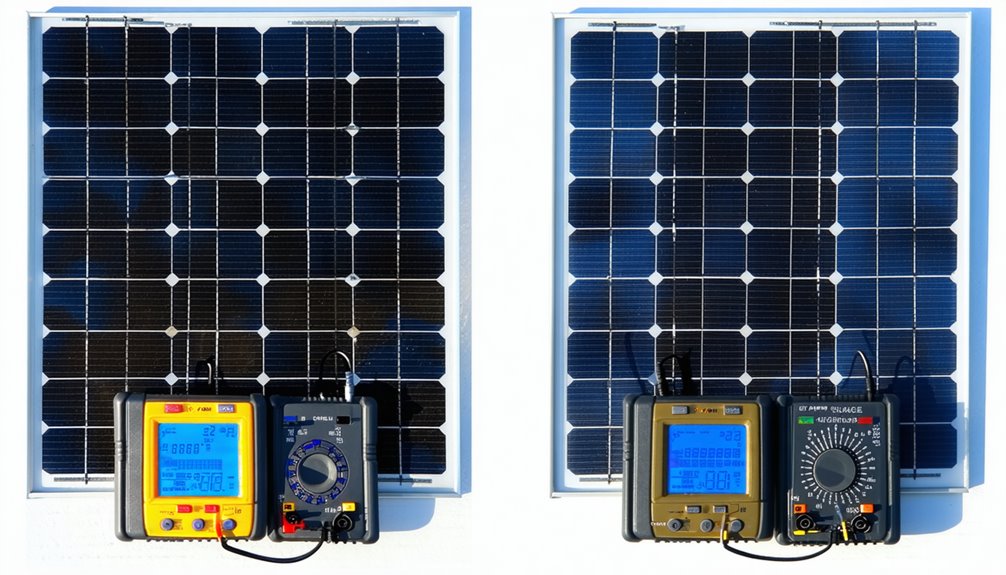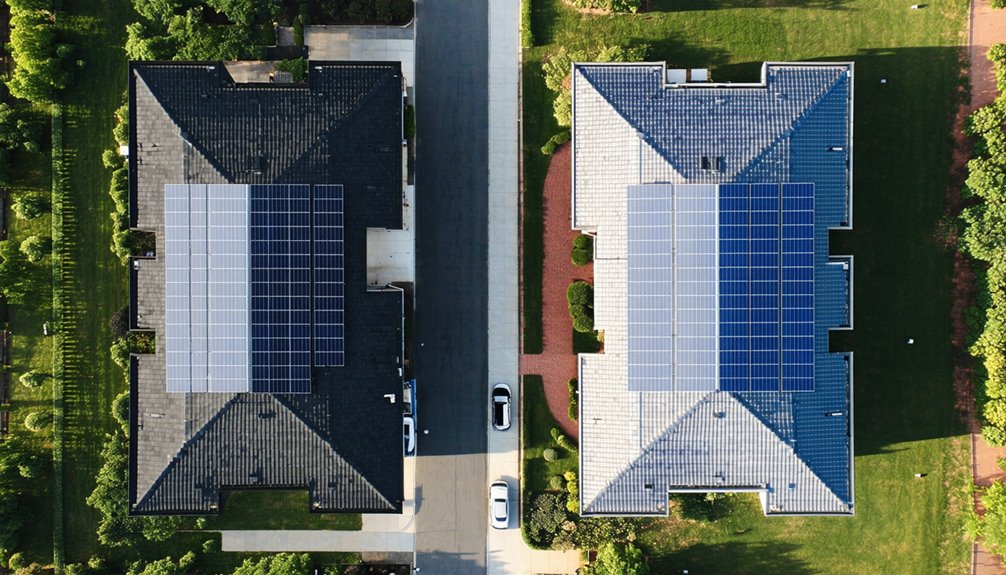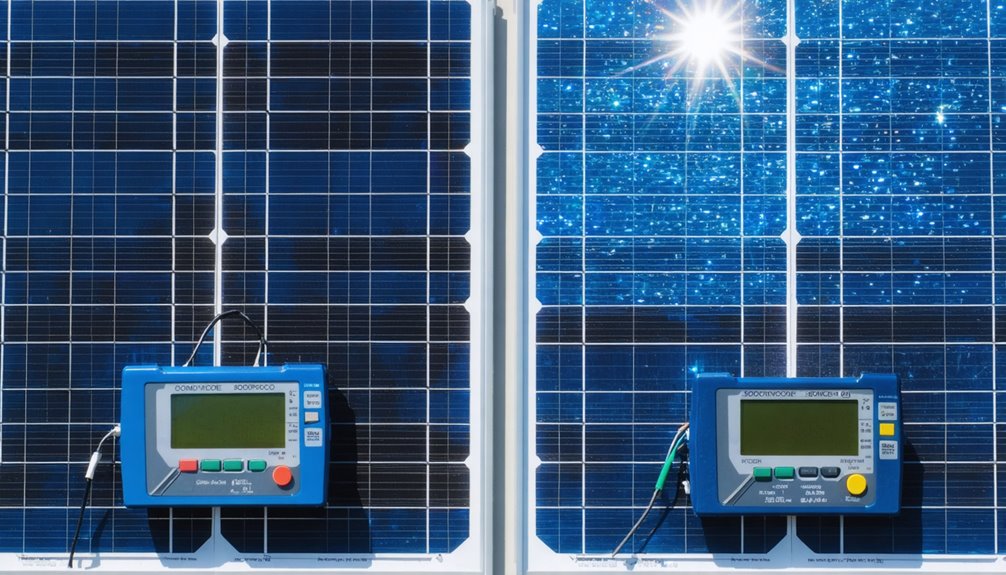You’re deciding between monocrystalline and polycrystalline solar panels, and efficiency often tips the scales. Monocrystalline ones convert sunlight into energy at higher rates, but polycrystalline options cost less upfront. You need to weigh how these differences affect your home’s energy output and long-term savings. What if temperature and space constraints change everything?
Key Takeaways
- Monocrystalline panels offer higher efficiency rates of 17% to 22%, surpassing polycrystalline’s 15% to 17%.
- Monocrystalline panels produce more energy per square foot, requiring fewer units than polycrystalline.
- In high temperatures, monocrystalline efficiency drops less, yielding up to 10% more energy than polycrystalline.
- Monocrystalline panels perform better in partial shading, maintaining reliable output compared to polycrystalline.
- With a 25-year lifespan, monocrystalline provides greater long-term efficiency and ROI over polycrystalline.
Understanding Monocrystalline Solar Panels

If you’re considering solar options, you’ll find monocrystalline panels stand out with efficiency ratings from 15% to 23%, making them highly suitable for homes.
You appreciate their black, uniform appearance, which signals high-purity silicon and a single crystal structure for peak performance.
You’ll generate more power per square foot with these panels, so they’re perfect if you’ve got limited roof space.
Choose a reputable solar panel supplier to guarantee quality installation and maximize output.
You benefit from their superior temperature coefficient, as they handle heat better and lose less efficiency in warm climates.
Expect a 25-year warranty, assuring durability and consistent energy production over decades.
You’ll invest wisely in monocrystalline for long-term savings.
When selecting monocrystalline panels, prioritize Tier-1 Solar Panels to ensure top-quality and reliability for your home.
Exploring Polycrystalline Solar Panels
You might opt for polycrystalline solar panels if budget tops your priorities, as manufacturers introduced them in 1981 with a simpler, cost-effective process that keeps prices low—around $215 per panel.
You’ll notice their distinctive blue color and variegated pattern, which come from melting multiple silicon crystal fragments together during production. This method affects their overall efficiency and performance, typically ranging from 13% to 16%.
You should consider their drawbacks, though. These panels have lower heat tolerance, so they lose efficiency in high temperatures and often last shorter than other types.
Plus, you’ll need more installation space to match the energy output of alternatives, making them less ideal for cramped rooftops.
Despite this, their affordability suits many budget-conscious setups.
Key Efficiency Metrics Comparison
When comparing monocrystalline and polycrystalline solar panels, you’ll find monocrystalline ones deliver higher efficiency rates of 17% to 22%, outpacing polycrystalline panels’ 15% to 17% range and producing more power in limited spaces.
You’ll appreciate how monocrystalline panels excel in partial shading, as they maintain reliable energy output even with obstructions, unlike polycrystalline ones that falter more easily. This makes them ideal if you’re dealing with rooftops or areas prone to shadows.
For a fixed installation area, you get more energy from monocrystalline panels, so you’ll need fewer units to achieve the same output as polycrystalline setups. They’re perfect for space-constrained spots like urban homes or small lots.
Plus, monocrystalline panels boast a longer lifespan of around 25 years, ensuring sustained efficiency and greater total energy generation over time compared to polycrystalline options. You’ll see better long-term returns on your investment.
Impact of Temperature on Efficiency
High temperatures impact solar panel efficiency, yet monocrystalline panels outperform polycrystalline ones with better temperature coefficients.
As you consider solar options, you’ll notice monocrystalline panels typically show coefficients from -0.2% to -0.3% per degree Celsius, meaning they lose less efficiency when heat rises.
In contrast, polycrystalline panels range from -0.3% to -0.5% per degree Celsius, so they suffer more significant drops.
Under high-temperature conditions, you see monocrystalline panels maintain higher energy output with a significantly lower efficiency decline.
In warm weather, they often generate up to 10% more energy than polycrystalline counterparts due to superior thermal performance.
Meanwhile, polycrystalline panels experience a pronounced output decrease, which diminishes their overall efficiency and can shorten lifespan in hotter climates.
You’ll benefit from monocrystalline’s resilience if you live in sunny, warm areas.
Space Efficiency and Installation Considerations

Monocrystalline panels excel in space efficiency, delivering higher power output per square foot—typically 320 to 375 watts—which suits installations with limited area.
You’ll find that their 17% to 22% efficiency means you need fewer panels to meet your energy needs, unlike polycrystalline ones at 15% to 17%.
With polycrystalline panels, you face a less efficient design that demands more space for equivalent energy production.
This leads to larger arrays and potentially higher installation costs, as you cover bigger areas to match output.
You benefit from monocrystalline panels‘ straightforward rooftop setups in constrained spaces, maintaining strong energy production.
Plus, they perform better in warmer temperatures, so you optimize output in hot climates without expanding your installation footprint.
Conclusion
When you’re deciding between monocrystalline and polycrystalline solar panels, you’ll find monocrystalline ones deliver superior efficiency—up to 22% versus polycrystalline’s 17%. You’ll generate more power in limited spaces, even under partial shade or high temperatures, ensuring better long-term savings. Don’t settle for less; choose monocrystalline for maximum energy production and durability that boosts your investment returns. You’ll appreciate their reliability and performance in any home setup.


